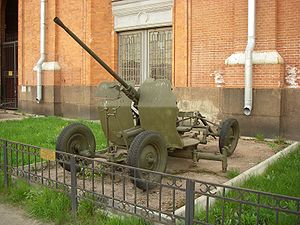This article has multiple issues. Please help improve it or discuss these issues on the talk page. (Learn how and when to remove these messages)
|
| 25 mm automatic air defense gun M1940 (72-K) | |
|---|---|
 72-K in Saint Petersburg Artillery Museum. | |
| Type | Anti-aircraft gun Autocannon |
| Place of origin | USSR |
| Service history | |
| In service | 1941–1960 |
| Production history | |
| Designed | 1939-1940 |
| Produced | 1941–1945 |
| No. built | 4,860 |
| Specifications | |
| Mass | 1,210 kg (2,670 lb) |
| Length | 5.3 m (17 ft 5 in) |
| Width | 1.7 m (5 ft 7 in) |
| Height | 1.8 m (5 ft 11 in) |
| Crew | 6 |
| Shell | 25×218mmSR |
| Caliber | 25 mm (0.98 in) |
| Elevation | -10 to +85 ° |
| Traverse | 360° |
| Rate of fire | 240 rpm |
| Muzzle velocity | 910 m/s (3,000 ft/s) |
| Maximum firing range | 2,400 m (7,900 ft) |
25 mm automatic air defense gun M1940 (72-K) (Russian: 25-мм автоматическая зенитная пушка образца 1940 года (72-К)) was a Soviet 25 mm caliber anti-aircraft gun used during the World War II. The gun was developed from the end of 1939 to the beginning of 1940 at 8th Kalinin Artillery Plant under the guidance of its Chief Designer Mikhail Loginov, supervised by Lev Loktev. The cannon was given the factory code 72-K before being accepted into service by the Red Army as the 25 mm automatic air defense gun M1940.
The gun borrowed a number of features from the older 37 mm automatic air defense gun M1939, such as mounting the gun on an integral four-wheel chassis (which came under criticism when compared to similar anti-aircraft guns from outside the Soviet Union). The gun itself generally satisfied the Army, and its ballistic performance was considered state-of-the-art on the world level.
The 72-K was designed for anti-aircraft defense for infantry regiments, occupying a place between the large-caliber DShK and the more powerful 37mm 61-K. However, due to difficulties in mass production, the 72-K did not reach the Red Army until the second half of the war. The 72-K and its paired-up variant, the 94-KM, were highly successful at engaging low-flying and diving targets, and continued to serve in the Red Army long after the end of the World War II, before being replaced by the more modern ZU-23 in the first half of the 1960s.